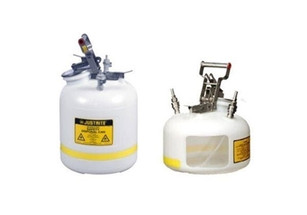Posted by Chrom Tech on 11th Dec 2025
How Do You Dispose of HPLC Waste?
High-Performance Liquid Chromatography (HPLC) is an essential analytical technique used across industries to separate complex mixtures into individual components. Whether quantifying unknown analytes or identifying known compounds, analysts rely on HPLC for accurate, reproducible results. However, this precision comes at a cost—HPLC systems produce hazardous solvent waste that must be safely collected and disposed of. In this post, we’ll explore a simple and compliant solution for managing HPLC solvent waste while protecting both your personnel and your equipment.
Understanding the Flow Path of an HPLC System

An HPLC pump delivers solvent (often flammable or hazardous) from the reservoir bottle through the system. This solvent—called the mobile phase—passes through the injector, column, and detector before finally reaching the waste reservoir. The column is the system’s heart, separating analytes based on their interaction with the stationary phase, while the detector translates this interaction into a signal to create a chromatogram.
Once analysis is complete, the solvent and sample mixture exit the detector and flow into the HPLC waste reservoir. Unfortunately, many labs still use repurposed solvent bottles—sometimes loosely covered with parafilm or lacking secondary containment altogether. These setups not only violate environmental health and safety (EHS) standards but also create fire and exposure hazards.
A Safer Solution for HPLC Solvent Waste Collection

Chrom Tech recommends using the Justrite HPLC Safety Disposal Can—a closed, compliant, and easy-to-use waste collection solution. Hazardous waste regulations require containers to remain sealed except when actively adding or removing waste. The Justrite can ensures compliance while reducing exposure and fire risk.
- Quick-connect fittings: The can includes one intake and one vent port. A 6-port manifold allows multiple HPLC systems to drain into a single container, simplifying waste management.
- Vapor filtration: An activated carbon vapor filter attaches to the vent to trap harmful vapors, preventing them from escaping into the lab environment. Filters typically last 3–6 months depending on solvent load.
- Safety features: The translucent polyethylene container allows quick visual inspection of fluid levels, while a stainless-steel flame arrester prevents flashback ignition. The spring-loaded lid automatically vents to prevent pressure buildup.
Even with these safeguards, secondary containment (such as a spill tray or bin) is recommended to catch accidental overflow. If a Justrite can does overflow, solvent will exit through the vapor filter rather than backflow into the HPLC system, ensuring no damage to your equipment.
Proper Handling and Disposal of HPLC Waste
When your HPLC waste container is full, simply disconnect it using the push-button quick-connect. Once detached, the container automatically seals, preventing leaks or spills. To transfer waste, connect the container to an approved collection drum using proper grounding and bonding techniques:
- Use antistatic wires to prevent static discharge during solvent transfer.
- Bond the container to the receiving drum, then ground the drum to a verified earth point.
- Always wear appropriate PPE, including chemical-resistant gloves and safety goggles.
Managing Waste from Multiple HPLC Systems
For high-throughput or multi-system laboratories, Chrom Tech recommends the All-Flo air-operated diaphragm pump for efficient waste transfer. This pump operates without electricity, eliminating spark hazards and offering hands-free waste management.
- Connect static-conductive tubing from the pump inlet to your Justrite Safety Container via quick-connect.
- Plumb the outlet tubing directly to your collection drum with a ½” FMNT bung adapter.
- The pump remains permanently ready for safe, static-free solvent transfer.
Tech Tip: When your waste container is not connected to the pump, remove the solvent pickup adapter to maintain a sealed system. Leaving it attached can leave the system open to the environment, which is not compliant with EHS standards.

Conclusion
Proper solvent waste management is critical for maintaining both lab safety and regulatory compliance. Chrom Tech offers a complete range of HPLC solvent waste containment solutions to protect your team and streamline hazardous waste collection. Reach out to our support team to discuss HPLC Safety Waste Systems that best fit your laboratory needs.
Frequently Asked Questions About HPLC Solvent Waste Disposal
Why can’t I use a regular solvent bottle for HPLC waste?
Reusing solvent bottles is unsafe and noncompliant. They are not sealed, vented, or grounded properly, increasing the risk of spills, fire, and chemical exposure. Using a closed safety system like the Justrite container ensures compliance with hazardous waste regulations.
How often should I replace the vapor filter on my HPLC waste can?
Most laboratories replace vapor filters every 3–6 months depending on solvent type, waste composition, and usage frequency. Replace sooner if odors are detected or if the can overflows.
What’s the safest way to transfer waste from the container to a disposal drum?
Use the All-Flo air-operated diaphragm pump to safely move flammable solvents without electricity. Always ground both containers and use antistatic tubing to prevent sparks during transfer.


